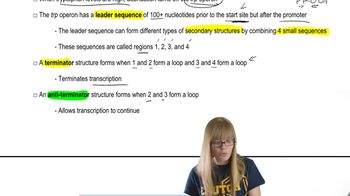Table of contents
- 1. Introduction to Genetics51m
- 2. Mendel's Laws of Inheritance3h 37m
- 3. Extensions to Mendelian Inheritance2h 41m
- 4. Genetic Mapping and Linkage2h 28m
- 5. Genetics of Bacteria and Viruses1h 21m
- 6. Chromosomal Variation1h 48m
- 7. DNA and Chromosome Structure56m
- 8. DNA Replication1h 10m
- 9. Mitosis and Meiosis1h 34m
- 10. Transcription1h 0m
- 11. Translation58m
- 12. Gene Regulation in Prokaryotes1h 19m
- 13. Gene Regulation in Eukaryotes44m
- 14. Genetic Control of Development44m
- 15. Genomes and Genomics1h 50m
- 16. Transposable Elements47m
- 17. Mutation, Repair, and Recombination1h 6m
- 18. Molecular Genetic Tools19m
- 19. Cancer Genetics29m
- 20. Quantitative Genetics1h 26m
- 21. Population Genetics50m
- 22. Evolutionary Genetics29m
12. Gene Regulation in Prokaryotes
Riboswitches
Problem 16
Textbook Question
Both attenuation of the trp operon in E. coli and riboswitches in B. subtilis rely on changes in the secondary structure of the leader regions of mRNA to regulate gene expression. Compare and contrast the specific mechanisms in these two types of regulation with that involving short noncoding RNAs (sRNAs).
 Verified step by step guidance
Verified step by step guidance1
Understand the concept of attenuation in the trp operon: In E. coli, the trp operon is regulated by attenuation, which involves the formation of alternative secondary structures in the leader region of the mRNA. When tryptophan levels are high, a terminator structure forms, halting transcription. When tryptophan is low, an anti-terminator structure forms, allowing transcription to continue.
Explore riboswitches in B. subtilis: Riboswitches are regulatory segments of mRNA that bind small molecules, causing a change in the mRNA's secondary structure. This change can either promote or inhibit the expression of downstream genes. In B. subtilis, riboswitches can control gene expression by altering the accessibility of the ribosome binding site or by forming transcription terminator structures.
Examine the role of short noncoding RNAs (sRNAs): sRNAs are small RNA molecules that regulate gene expression post-transcriptionally. They typically function by base-pairing with target mRNAs, affecting their stability or translation. sRNAs can either promote degradation of the mRNA or block the ribosome binding site, preventing translation.
Compare the mechanisms: Both attenuation and riboswitches involve changes in mRNA secondary structure to regulate gene expression, but attenuation is primarily a transcriptional control mechanism, while riboswitches can affect both transcription and translation. sRNAs, on the other hand, regulate gene expression post-transcriptionally by interacting with mRNA directly.
Contrast the regulatory outcomes: Attenuation and riboswitches rely on the presence or absence of specific metabolites to induce structural changes in mRNA, leading to either termination or continuation of transcription. sRNAs do not rely on metabolite binding but instead use complementary base-pairing to modulate mRNA stability or translation, providing a different layer of gene regulation.
Recommended similar problem, with video answer:
 Verified Solution
Verified SolutionThis video solution was recommended by our tutors as helpful for the problem above
Video duration:
49sPlay a video:
Was this helpful?
Key Concepts
Here are the essential concepts you must grasp in order to answer the question correctly.
Attenuation in the trp operon
Attenuation is a regulatory mechanism in the trp operon of E. coli that controls gene expression based on tryptophan levels. It involves the formation of different secondary structures in the mRNA leader sequence, which can either promote or inhibit transcription. When tryptophan is abundant, a structure that terminates transcription is favored, while low levels allow for a structure that permits transcription to continue.
Recommended video:
Guided course

Trp Attenuation
Riboswitches in B. subtilis
Riboswitches are segments of mRNA that can change their secondary structure in response to specific metabolites, thereby regulating gene expression. In B. subtilis, the binding of a metabolite to the riboswitch can lead to the formation of a structure that either sequesters the ribosome binding site or promotes transcription termination, effectively controlling the synthesis of proteins based on the cellular environment.
Recommended video:
Guided course

Riboswitches
Short noncoding RNAs (sRNAs)
Short noncoding RNAs (sRNAs) are regulatory RNA molecules that can modulate gene expression by base-pairing with target mRNAs. They often influence the stability and translation of mRNAs by altering their secondary structures or by recruiting proteins that affect mRNA degradation. Unlike attenuation and riboswitches, which are intrinsic to the mRNA itself, sRNAs act as trans-acting factors that can regulate multiple targets.
Recommended video:
Related Videos
Related Practice




